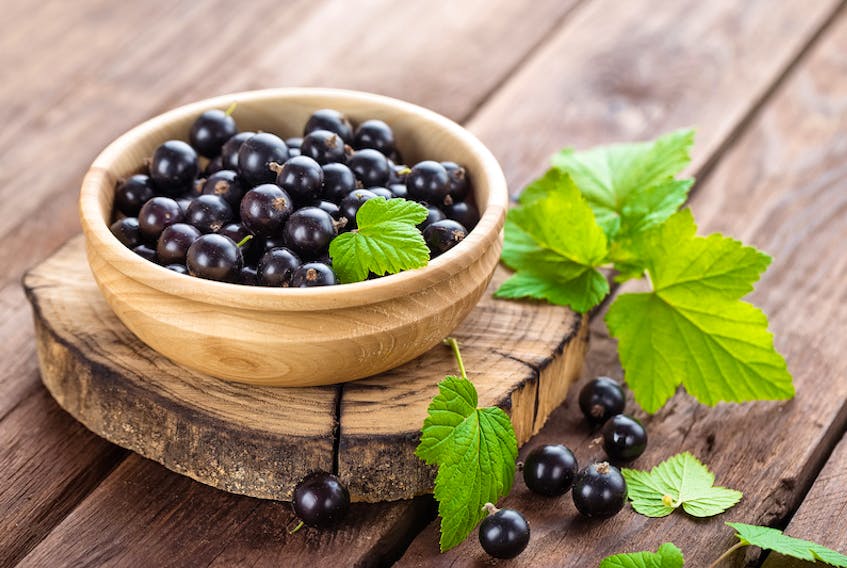Every year my friend invites me to pick black currants from the patch in her garden. I have generous friends!
Since black currants have plenty of pectin and acid, both required for making jam or jelly, it is not necessary to supplement either with commercial pectin or lemon juice. You can find recipes for making currant jam using commercial pectin, but I like to take advantage of the natural attributes of this fruit, and make jam with just currants, water and sugar.
Here is the recipe I use. I adapted it from one in a long out-of-print Agriculture Canada publication, and bottle it in 250 mL (1 cup) mason jars and process in a boiling water bath according to current recommendations for jams and jellies. I’ve included instructions for doing this.
My boiling water canner will accommodate seven jars. When preparing this jam, I keep an extra jar available in case there is more than enough to fill the seven. This one can be kept in the fridge, unprocessed, to use first.
Cook the jam in a kettle or stockpot large enough, 8-10 l, to allow for boiling, because cleaning black currant splashes from the stovetop is not fun. Pots with a heavy bottom are best for jam making, and prevent burning.
Black Currant Jam
1.5 L (6 cups) black currants (about 1.2 kg/2.6 lb)
1.25 L (5 cups) water
1625 mL (6½ cups) sugar
Place 7 clean 250 mL (1 cup) canning jars, upright, in a boiling water canner. Cover with water and bring to a simmer. Heat snap lids (just the flat disks) in hot – not boiling – water. Keep jars and snap lids hot until ready to use.
Have screw bands handy, as well as a jar lifter to remove bottles from boiling water, a ladle, wide-mouth funnel, small spatula and clean damp cloth.
Place several small plates in the freezer. You’ll use these to determine whether the fruit has reached the jam stage.
Rinse currants in cold water, and stem. Combine black currants and water in a heavy saucepan. Bring to a boil and cook, uncovered, for 15 minutes, stirring often to prevent sticking. Start timing when the mixture begins to boil vigorously.
Remove from heat and stir in the sugar to dissolve. Bring mixture to a full rolling boil (simmering will produce a syrupy mix, not a jam), and stir frequently to prevent sticking. Boil to the jam stage, about 12 minutes.
To determine when the cooked fruit mixture has reached the jam stage, remove the stockpot from the heat and place about 2 mL (½ tsp) of the mixture on a chilled plate. Let it cool briefly, and return it to the freezer for 1 minute. Tilt the plate. For a softly set jam, the mixture will flow very slowly. For a firm set, the mixture will be firm and wrinkle when the edge is pushed with a finger.
If it hasn’t reached the jam stage, return the pot to the stove, cook for another 2 minutes, and repeat the test on another chilled plate.
When mixture has reached jam stage, remove jars from canner, fill and cover one at a time. Ladle jam into a hot jar to within 0.5 cm (¼ inch) of top; the empty space at the top is called headspace. Remove trapped air bubbles by sliding a rubber or silicone spatula through the contents, and spoon in a little more jam if necessary for the 0.5 cm headspace. Wipe the jar rim with a clean damp cloth to remove any stickiness, centre snap lid on the jar, and apply the screw band until fingertip tight. If it is tightened too much, the lid may buckle, making a vacuum seal impossible. Place filled jar to rack in canner. Repeat for remaining jam.
When all the jars are filled and placed in the canner, adjust the water level to cover the tops by 2.5-5 cm (1-2 inches). Cover the canner and return the water to a full rolling boil before starting timing. Process (boil the jars) for 10 minutes.
Remove canner cover, and let stand for 5 minutes. Then remove jars from canner without tilting, place them upright on a surface covered with newspapers or towels, and cool, undisturbed, for 24 hours. Label and store.
Margaret Prouse, a home economist, writes this column for The Guardian every Friday. She can be reached by email at [email protected].









